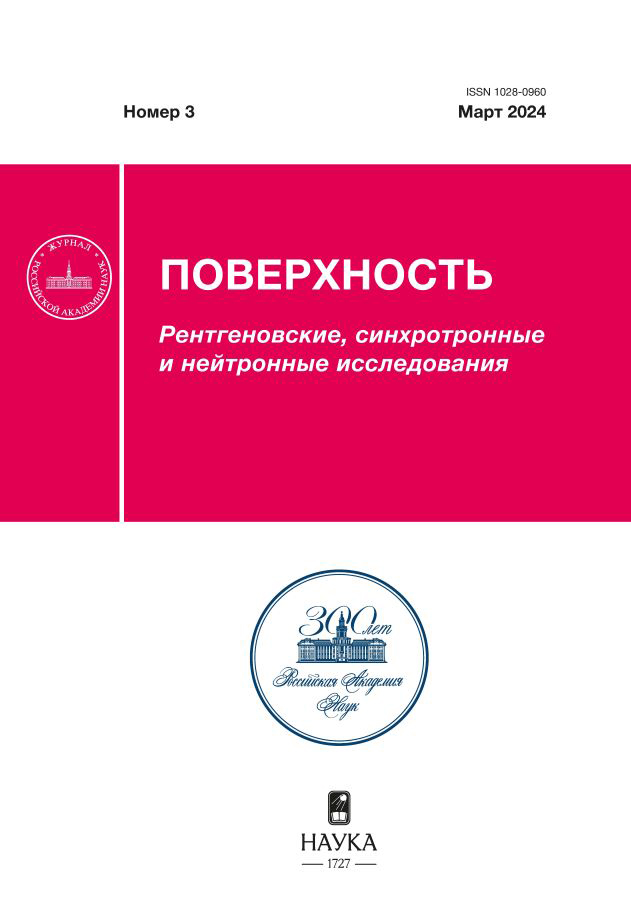Formation of bismuth nanoparticles on nanoporous substrates
- Авторлар: Supelnyak S.I.1, Artemov V.V.1
-
Мекемелер:
- FSRC “Crystallography and Photonics” RAS
- Шығарылым: № 3 (2024)
- Беттер: 39-43
- Бөлім: Articles
- URL: https://kazanmedjournal.ru/1028-0960/article/view/664669
- DOI: https://doi.org/10.31857/S1028096024030069
- EDN: https://elibrary.ru/hfmyap
- ID: 664669
Дәйексөз келтіру
Аннотация
Substrates with a layer of anodized aluminum oxide are obtained by one-stage and two-stage anodization. The samples had different porosity in volume and on the surface. Bismuth nanoparticles were obtained by thermal evaporation in argon by condensation onto substrates with a layer of anodized aluminum oxide. The distribution of sizes, shapes, and numbers of nano- and microparticles was studied using images obtained with a scanning electron microscope. The largest number of nanoparticles (21%) on the sample with a surface layer of aluminum oxide without pores had a diameter of 70 nm. It was assumed that the presence of pores on the surface affected the migration of deposited atoms and particles of bismuth melt until stable condensation centers were formed. The presence of pores with a diameter of 20–100 nm led to a decrease in the diameter of the most common bismuth nanoparticles from 80 to 40 nm. Nanoparticles with a diameter of 90 nm were predominant (25%) in the sample with pores with a diameter of 60–220 nm. The largest number of spherical crystallites on all substrates had a diameter of 110 nm. It was established that a uniform distribution of particles was obtained on a sample, the surface of which was not subjected to chemical polishing.
Негізгі сөздер
Толық мәтін
Авторлар туралы
S. Supelnyak
FSRC “Crystallography and Photonics” RAS
Хат алмасуға жауапты Автор.
Email: supelnyak@gmail.com
Shubnikov Institute of Crystallography
Ресей, 119333, MoscowV. Artemov
FSRC “Crystallography and Photonics” RAS
Email: supelnyak@gmail.com
Shubnikov Institute of Crystallography
Ресей, 119333, MoscowӘдебиет тізімі
- Brandt N.B., Dolgolenko T.F., Stupochenko N.N. // Sov. Phys. JETP. 1964. V. 18. № 4. P. 908.
- Sandomirskii V.B. // Sov. Phys. JETP. 1967. V. 25. № 1. P. 101.
- Saikawa K. //J. Phys. Soc. Jpn. 1970. V. 29. № 3. P. 570. https://www.doi.org/10.1143/JPSJ.29.562
- Эдельман В.С. // Успехи физических наук. 1977. Т. 123. № 10. С. 257. https://www.doi.org/10.3367/UFNr.0123.197710d.0257
- Toudert J., Serna R., Deeb C., Rebollar E. // Opt. Mater. Express. 2019. V. 9. № 7. P. 2924. https://www.doi.org/10.1364/OME.9.002924
- Romanov A.N., Haula E.V., Korchak V.N. // Quantum Electronics. 2020. V. 50. № 10. P. 910. https://www.doi.org/10.1070/QEL17250
- Liu S., Tian J., Zhang W. // Nanotechnology. 2021. V. 32. № 22. P. 222001. https://www.doi.org/10.1088/1361-6528/abe25f
- Kim J., Shim W., Lee W. // J. Mater. Chem. C. 2015. V. 3. № 46. P. 11999. https://www.doi.org/10.1039/x0xx00000x
- Goncharova A.S., Napolskii K.S., Skryabina O.V., Stolyarov V.S., Levin E.E., Egorov S.V., Eliseev A.A., Kasumov Yu.A., Ryazanov V.V., Tsirlinab G.A. // Phys. Chem. Chem. Phys. 2020. V. 22. № 26. P. 14953. https://www.doi.org/10.1039/D0CP01111H
- Lee P.C., Wei P.C., Chen Y.Y. // Nanomaterials. 2021. V. 11. № 3. P. 819. https://www.doi.org/10.3390/nano11030819
- Rehman A.Ur., Ashraf M.W., Tayyaba S., Bashir M., Wasim M.F., Imran M. // Dig. J. Nanomater. Biostructures. 2021. V. 16. № 1. P. 231.
- Kozhemyakin G.N., Artemov V.V., Kiiko A.V., Kiiko S.A., Bryl O.E. // Russ. Metallurgy (Metally). 2021. № 1. P. 68. https://www.doi.org/10.1134/S0036029521010079
- Кожемякин Г.Н., Ковалев С.Ю., Соклакова О.Н. // Физика и химия обработки материалов. 2019. № 5. С.68. https://www.doi.org/10.30791/0015-3214-2019-5-68-73
- Бабичев А.П., Бабушкина Н.А., Братковский А.М. и др. Физические величины: справочник / Ред. Григорьев И.С., Мелихов Е.З. М.: Энергоатомиздат, 1991. 1232 с.
- Кожемякин Г.Н., Брыль О.Е., Панич Е.А., Довгалюк А.И., Савицкий И.В., Ярмов А.А. // Кристаллография. 2019. Т. 64. № 2. С. 1. https://www.doi.org/10.1134/S0023476119020188
- Егоров В.М., Урюпин О.Н., Иванов Ю.В. // Физика твердого тела. 2015. Т. 57. Вып. 9. С. 1798.
- Kellermann G., Craievich A.F. // Phys. Rev. B. 2008. V. 78. № 5. P. 054106. https://www.doi.org/10.1103/PhysRevB.78.054106
- Li Y., Zang L., Jacobs D.L., Zhao J., Yue X., Wang C. // Nature Commun. 2017. V. 8. № 1. P. 1. https://www.doi.org/10.1038/ncomms14462
- Lee J., Kim Y., Jung U., Chung W. // Mater. Chem. Phys. 2013. V. 141. № 2–3. P. 680. https://www.doi.org/10.1016/j.matchemphys.2013.05.058
- Vera-Londono L., Ruiz-Clavijo A., Caballero-Calero O., Martín-González M. // Nanoscale Adv. 2020. V. 2. № 10. P. 4591. https://www.doi.org/10.1039/D0NA00578A
Қосымша файлдар












